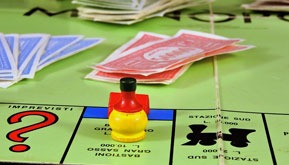The hobby of playing board games has been a part of childhood for most people. It is a staple for family gatherings and friendly get-togethers. In this era when video gaming and playing onscreen have become mainstream, we never expected that board games will still be popular, but the Internet has somehow revived the people’s interest in tabletop gaming. As people begin to rediscover classic board games, it sparked the “need” to play it physically, causing the rise in sales of board games compared to the past decade. Tabletop board gaming is gaining popularity nowadays, and many coffee houses and restaurants are offering board games to entice customers.
How did our ancestors come to invent board games? You may think that it was invented just centuries ago, but actually, people have been playing games on top of the table since the prehistoric times.

By the way, the earliest gaming pieces ever found was dice – a piece that is essential to most board games. A series of 49 small, carved painted stones were found in a 5,000-year-old burial mound in southeast Turkey. Early dice were created by painting a single side of flat sticks. In Mesopotamia, a variety of materials were used including wood, stones, knuckle bones, and shells. The six-sided dice we’re using today got its roots from the dice from the Roman era.
Another famous game in ancient Egypt is the Mehen. It was another popular board game representing the snake god Mehen who wrapped the Sun God Re in its coils. The rules weren’t discovered, but the Hyena game from the Arab region share many similarities and its gameplay have been adapted for the game of Mehen.
The Royal Game of Ur is another ancient board game, but it was available to common people of Ur civilization. It is the longest running board game as it was around 5,000 years already. It is a racing game played with two sets, of three four-sided dice and seven markers. There was one set was found in Tutankhamen’s tomb.
During 2,000 BC, the first ancestor of Backgammon was found. The game Ludus duodecim scriptorium, or “game of twelve markings,” was popular during the Roman Empire, likely referring to three rows of 12 markings found on surviving boards. The objective of the game was to be the first to get rid of all checkers in the board before opponents, same as modern backgammon. The only difference was the use of extra die and the starting of all pieces off the board.
By mid-1960s, backgammon became popular, partly because of the charisma of Prince Alexis Obolensky, who eventually became “The Father of Modern Backgammon.” He established the International Backgammon Association and its official rules for gameplay. The game became a huge hit and was played on college campuses, country clubs, and discotheques. It also became a popular gift for college students and professionals alike. The first major international tournament was launched in 1964, attracting royalties, celebrities, and the media. In 1967, a World Championship was promoted in Las Vegas.
The earliest game with a resemblance to chess was Ludus latrunculorum or latrones, a two-player strategy board game played during the Roman Empire generally accepted to be a game of military tactics. The game has many pieces played on a checkerboard type pattern. The board is called “city,” and each game piece is called “dog,” which are of two colors. The art of the game is to take a piece of color by enclosing it between two pieces of the other color. It was believed to have influenced the historical development of early chess, especially the movement of the pawns.
The first board games of the ancient culture were played mostly by adults, but it was quickly adopted by children. One of the first games developed for kids were Hopscotch, although it is not technically a board game. The first to play the game were Roman children from 500 BC. This ushered the start of playing board games as a part of childhood.
At around 400 BC, the Chinese people created their own board game called Liubo, meaning six sticks, and it became the first board game developed by the Asian society that was not an interpretation of Middle Eastern games. Liubo was played by two players, each with six game pieces moved around points on a square board with a symmetrical pattern. It was usually made of wood so only certain pieces survived, but a set of well-preserved Liubo game board was found during 1973. It was popular back during the Han Dynasty, but its popularity faded when the game called Go came to the scene.
There was another game dated to the 1st century AD that was discovered in a tomb of the Druid of Colchester in ancient Britain. It was one of the most fascinating discoveries in the history of board games because the game board seems complete. The origin of the game was unknown, but it was believed that it was the Roman soldiers who brought the game to Britain.
Years later, people were seen enjoying board games. There were drawings of Mayan king Montezuma II watching his nobles play a game called Patolli. It was a game of strategy and luck played all over Mesoamerica.
Meanwhile, in several Muslim countries in the Arab region to West Africa, a game called Tâb was played during the medieval times. It shared some similarities with the ancient Egyptian game Senet and Korean game Yut.
The most popular board game of all time – chess – was first played around 600 AD in the nearby Sassanid Persia. It was believed to have originated in Eastern India, wherein it was known as Chaturanga. The Chaturanga was played on an 8×8 uncheckered board with special markings, which meaning is unknown.
Chess reached Western Europe and Russia during the 900 AD, and by the year 1000, it had spread throughout Europe. The Persian form of Chess, or the Shatranj, was modified in southern Europe around 1200. By 1475, a set of major rule changes were made to the game for the basic moves of pawns, bishops, and queens, which basically became the most powerful piece. The new rule was first adopted in Spain and Italy, and it quickly spread throughout Western Europe. In the early 19th century, the rules for stalemate were finalized, leading to the gameplay rules of chess we know today.

The most prestigious award for board and card games were created in 1978 called Spiel des Jahres, or “Game of the Year.” It was given annually by a jury of German game critics. A nomination for Spiel des Jahres can increase the typical sales of a game from 500 to 10,000 copies, and the winner can expect to sell 300,000 to 500,000 copies.
The first European game to gain popularity outside Europe and the catalyst for the sudden popularity of board games was The Settlers of Catan. It was created in 1995 by a dental technician from Germany named Klaus Teuber. It had a different set of rules and mechanics as compared with usual American games, which made players engage with one another through aggression. European games, however, used indirect conflict and make players compete for the same pool of resources.
The objective of Settlers of Catan is to compete to colonize an island, build settlements and roads, and trade goods to build the most powerful faction among opponents. It was successful – it made people aware that board games could be about other things besides destroying each other or moving along a track. By 2014, 18 million copies of the game have been sold.
Since then, new board games with unique mechanics emerged through the years. Kickstarter, global a crowdfunding platform, became a huge help to the board game industry, as it began funding new games since 2009. It supported the tabletop community and gave them the chance to make their idea come to life. One famous board game launched through the Kickstarter campaign was The Conan board game.
One of the biggest catalysts for the sudden popularity of board gaming this decade was TableTop, a web series about board games created by Wil Wheaton and Felicia Day. It has been a resonating force in the gaming community and educated people who still have misconceptions about board gaming. The show became so popular and influential that the board games it features get skyrocketing sales after.
Since 2013, Wil and Felicia are holding annual International Tabletop Day – a live streaming event wherein they played several games with people from their previous episodes. They also announce different events and promotions where avid gamers can participate.
The tabletop gaming community has grown exponentially, but it is still very young. There were already a lot of board games released since ancient times, but there are more fun and entertaining games to come for sure. Board games are here to stay to give everyone a chance to enjoy.

